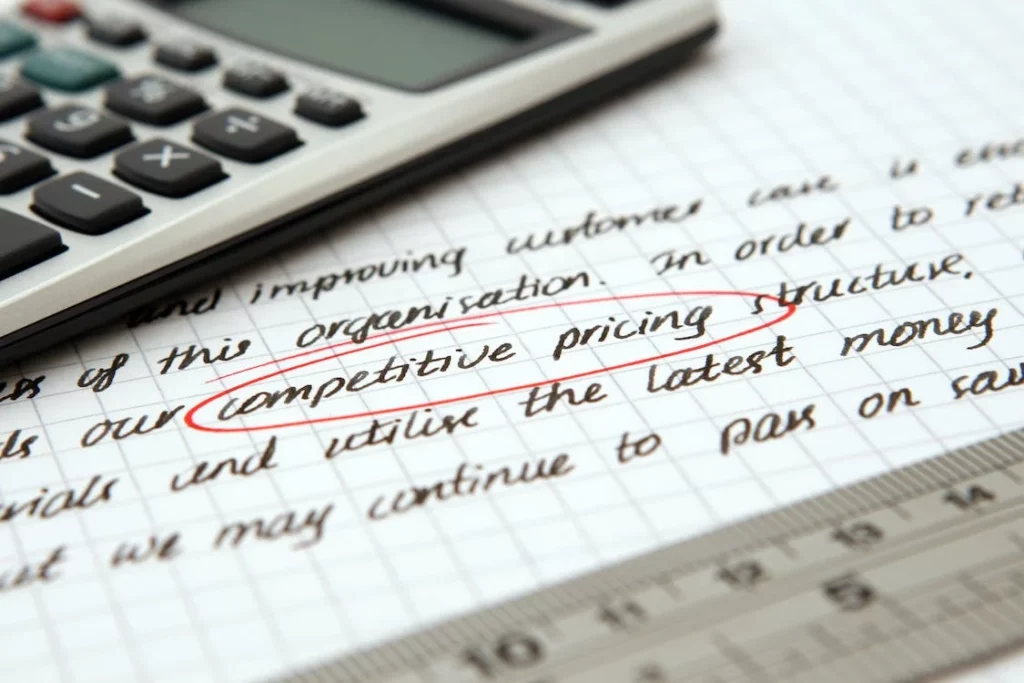What are the Types Of Pricing Strategies in Marketing?
Pricing strategy marketing refers to the strategic approach taken by businesses to set and adjust product or service prices to achieve specific marketing objectives. It involves analyzing various factors such as production costs, competitor pricing, customer behaviour, and market demand to determine the most effective pricing tactics. A well-crafted pricing strategy helps businesses position their offerings competitively, maximize profits, and create perceived value in the minds of customers.
Importance of Pricing Strategy in Marketing
Pricing is a crucial element of the marketing mix, alongside product, promotion, and place (distribution). The right pricing strategy can significantly impact a company’s success. It directly influences customer perception, purchase decisions, and brand positioning. A well-thought-out pricing strategy can attract target customers, enhance customer loyalty, and achieve sustainable competitive advantage. Conversely, a poorly designed pricing approach can lead to missed opportunities, lost revenue, and damage to brand reputation.
In this comprehensive guide, we will explore various types of pricing strategies used in marketing. Each section will delve into different pricing tactics, such as penetration pricing, skimming pricing, premium pricing, economy pricing, psychological pricing, dynamic pricing, bundle pricing, and optional pricing. We will analyze the benefits and drawbacks of each strategy, providing real-life examples of how companies implement them successfully.
Moreover, we will discuss the significance of understanding key pricing elements, including cost-based pricing, value-based pricing, and competition-based pricing. We’ll explore how psychological pricing techniques can influence consumer behaviour and how dynamic pricing allows businesses to adapt to changing market conditions.
Furthermore, this guide will address the critical role of pricing in the context of the marketing mix, integrating pricing with other marketing strategies, and its impact on brand positioning and customer decision-making.
By the end of this journey, you will gain valuable insights into crafting an effective pricing strategy that aligns with your business objectives, enhances customer value perception, and positions your brand competitively in the market. Let’s dive in and unlock the power of pricing strategy marketing!
What are the Key Elements of Pricing Strategy?
Understanding these key elements of pricing strategy is vital for businesses to make informed pricing decisions. Each approach has its advantages and drawbacks, and successful pricing strategies often combine elements of multiple approaches to create a well-rounded and effective pricing plan. In the following sections, we will explore various types of pricing strategies that leverage these key elements to achieve specific marketing objectives.
Types Of Pricing Strategy Marketing
1. Penetration Pricing: Gaining Market Share
Penetration pricing is a pricing strategy where a company sets its initial product price lower than the market average to attract a large number of customers quickly. The primary purpose of penetration pricing is to gain significant market share, especially in highly competitive industries or when introducing a new product to the market. By offering products at a lower price, businesses aim to entice price-sensitive customers and build brand awareness, effectively penetrating the market.
Benefits and Risks of Penetration Pricing:
Benefits:
Risks:
Real-Life Examples of Penetration Pricing:
- Smartphone Industry: When new smartphone models are launched, manufacturers often introduce them at a lower price point to attract early adopters and gain market share quickly.
- Streaming Services: Many streaming platforms offer free trials or discounted rates for new subscribers to encourage them to sign up and experience their content.
- Fast-Food Chains: Fast-food chains frequently introduce limited-time promotional offers with discounted prices to attract customers and boost sales during specific periods.
Penetration pricing can be a powerful tool for companies looking to make a strong market entry and gain a foothold in their industry. However, businesses must carefully weigh the benefits and risks and consider their long-term pricing strategy to ensure sustainable success.
2. Skimming Pricing: Capturing Premium Value
Skimming pricing is a pricing strategy where companies set high initial prices for new products or services, targeting early adopters and customers willing to pay a premium for novelty and exclusivity. The purpose of skimming pricing is to “skim” the market by maximizing profits from those customers who are eager to have the latest offering and are less price-sensitive. This approach is commonly used for innovative or technologically advanced products where demand is initially higher.
Advantages and Disadvantages of Skimming Pricing:
Advantages:
Disadvantages:
Real-Life Examples of Skimming Pricing:
- Tech Gadgets: When new smartphones or other tech gadgets are launched, companies often adopt skimming pricing to capitalize on early adopters’ willingness to pay a premium for the latest technology.
- Luxury Fashion: High-end fashion brands frequently use skimming pricing for limited-edition or exclusive collections, targeting affluent customers seeking unique and prestigious products.
- Gaming Consoles: Gaming console manufacturers often price their latest console models higher at launch to attract avid gamers and enthusiasts who want to be among the first to own the latest gaming technology.
Skimming pricing can be a lucrative strategy for businesses introducing innovative products or catering to a niche market of early adopters. However, careful consideration of market demand, competition, and pricing elasticity is essential to effectively implement this pricing approach.
3. Premium Pricing: Leveraging Brand Value
Premium pricing is a strategy where companies set higher prices for their products or services to convey a sense of superior quality, exclusivity, and value to customers. The purpose of premium pricing is to position the brand as a high-end or luxury option, appealing to customers who are willing to pay more for perceived enhanced features, craftsmanship, and status. Premium pricing is often employed by brands with strong brand equity and a reputation for exceptional quality and customer experience.
Pros and Cons of Premium Pricing:
Pros:
Cons:
Real-Life Examples of Premium Pricing:
- Luxury Automobiles: High-end automobile manufacturers price their luxury car models at premium levels, appealing to customers seeking top-notch performance, advanced features, and prestigious branding.
- Designer Fashion Brands: Renowned fashion houses price their designer clothing and accessories at premium levels to position their brand as an exclusive choice for discerning fashion enthusiasts.
- High-End Electronics: Companies producing premium audio equipment, high-end smartphones, and top-tier laptops often employ premium pricing to emphasize the quality and craftsmanship of their products.
Premium pricing is a strategy that can elevate a brand’s status and foster a strong sense of loyalty among customers. However, businesses must carefully balance price and value to maintain customer satisfaction and justify the premium positioning of their offerings.

4. Economy Pricing: Targeting Price-Sensitive Customers
Economy pricing is a pricing strategy where businesses set low prices for their products or services to target price-sensitive customers in the market. The primary purpose of economy pricing is to appeal to cost-conscious consumers who prioritize affordability over additional features or brand prestige. This pricing approach is commonly used by discount retailers and budget brands to reach a wide customer base and gain a competitive edge in price-sensitive markets.
Advantages and Disadvantages of Economy Pricing:
Advantages:
Disadvantages:
Real-Life Examples of Economy Pricing:
- Dollar Stores: Retailers like Dollar Tree and Dollar General are known for their economy pricing, offering a wide range of products at a fixed $1 price point.
- Budget Airlines: Low-cost airlines employ economy pricing to offer budget-friendly flight options to travellers.
- Generic Products: Generic or store-brand products often use economy pricing to compete with higher-priced branded alternatives.

5. Psychological Pricing Strategies
Psychological pricing strategies leverage human behaviour and perception to influence purchasing decisions. By implementing these techniques effectively, businesses can optimize sales and create favourable associations with their products.

6. Dynamic Pricing: Adapting to Market Conditions
Dynamic pricing, also known as surge pricing or demand-based pricing, is a flexible pricing strategy where businesses adjust product or service prices in real-time based on changes in market demand, customer behaviour, and other external factors. This approach relies on advanced algorithms and data analysis to optimize pricing and capture the maximum value from each transaction. Dynamic pricing is commonly used in industries where demand fluctuates rapidly, such as ride-sharing services, airline tickets, and hotel bookings.
Benefits and Challenges of Dynamic Pricing:
Benefits:
Challenges:
Industries Leveraging Dynamic Pricing:
- Ride-Sharing Services: Companies like Uber and Lyft use dynamic pricing to adjust fares based on demand and traffic conditions.
- E-commerce: Online retailers may implement dynamic pricing for products with fluctuating demand or during special sales events.
- Events and Concerts: Ticket sellers adjust prices based on demand and seat availability for concerts, sports events, and other entertainment.
7. Bundle Pricing: Offering Value Through Packaging
Bundle pricing is a strategy where businesses combine multiple products or services into a single package and offer them at a discounted price compared to purchasing each item individually. The purpose of bundle pricing is to encourage customers to make larger purchases and perceive added value from the package, leading to increased sales and customer satisfaction.
Advantages and Disadvantages of Bundle Pricing:
Advantages:
Disadvantages
Real-Life Examples of Bundle Pricing:
- Fast Food Combos: Fast-food chains offer combo meals that bundle a burger, fries, and a drink at a lower price than purchasing each item separately.
- Software Packages: Software companies offer different software packages that bundle various features at different price points to cater to different customer needs.
- Gym Memberships: Fitness centres provide membership bundles that include access to various facilities and classes at discounted rates.
Bundle pricing can be an effective strategy to drive sales, increase customer satisfaction, and manage inventory efficiently. However, businesses should carefully assess customer preferences and product combinations to offer compelling bundles that meet diverse customer needs.
8. Optional Pricing: Customizing for Consumer Preferences
Optional pricing, also known as a versioning strategy, is a pricing tactic where businesses offer different versions or variations of their products or services at varying price points. Each version caters to specific customer preferences and needs, allowing customers to choose the option that best aligns with their requirements. This approach allows businesses to cater to a diverse customer base effectively.
Pros and Cons of Optional Pricing:
Pros:
Cons:
Real-Life Examples of Optional Pricing:
- Software Licenses: Software companies offer different versions of their products with varying features and capabilities at different price points.
- Airlines: Airlines provide different ticket classes, such as economy, premium economy, business, and first class, each with distinct offerings and pricing.
- Streaming Services: Streaming platforms offer multiple subscription tiers with varying features and content access, catering to different user preferences.

9. Competitive Pricing: Navigating the Market Landscape
Analyzing competitors’ pricing strategies is crucial for businesses to position themselves effectively in the market. This involves researching and understanding how competitors price their products or services, identifying any unique selling points they offer, and assessing their pricing relative to the value they provide.
Strategies for Competitive Advantage:
- Differentiation: Businesses can differentiate their offerings from competitors through unique features, customer service, or branding, allowing them to command premium pricing.
- Cost Leadership: Cost-efficient businesses may choose a cost leadership strategy, enabling them to offer competitive prices while maintaining profitability.
- Value-Driven Pricing: Emphasizing value in marketing messages and demonstrating how the product or service meets customers’ needs can justify higher pricing.
Avoiding Price Wars and Race to the Bottom:
Engaging in price wars can be detrimental to all businesses involved. Instead, businesses should focus on providing unique value propositions, building brand loyalty, and focusing on customer satisfaction to avoid getting trapped in a race to the bottom.
Competitive pricing requires a careful balance between price, value, and market positioning. Businesses should continuously monitor the competitive landscape to make informed pricing decisions and maintain a sustainable competitive advantage.
Conclusion: Crafting an Effective Pricing Strategy
Throughout this comprehensive guide on pricing strategy marketing, we explored various pricing approaches and their applications in different business contexts. We discussed cost-based, value-based, and competition-based pricing, as well as several strategic pricing methods like penetration, skimming, premium, economy, dynamic, bundle, and optional pricing. Additionally, we delved into the use of psychological pricing techniques and how businesses can navigate competitive landscapes effectively.
Pricing strategy plays a pivotal role in the success of any marketing initiative. It directly impacts customer perception, brand positioning, profitability, and overall revenue. An effective pricing strategy aligns with business objectives, customer preferences, and market conditions to ensure sustained growth and competitive advantage.
As businesses strive to stand out in today’s dynamic markets, implementing the right pricing strategy becomes imperative. By carefully assessing their unique offerings, target audience, and competitive landscape, businesses can identify the most suitable pricing approach to drive sales, enhance brand value, and foster customer loyalty.
Remember that pricing strategies are not one-size-fits-all solutions, and experimentation and data analysis are essential for fine-tuning pricing decisions. We encourage you to explore and implement the pricing strategies discussed in this guide that best suit your business goals and target market. By crafting an effective pricing strategy, you can position your business for growth and success in the ever-evolving world of marketing.



